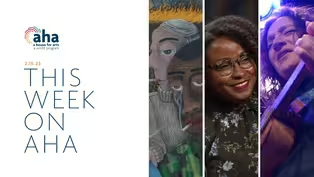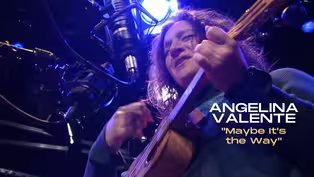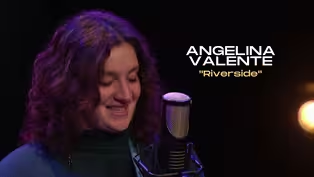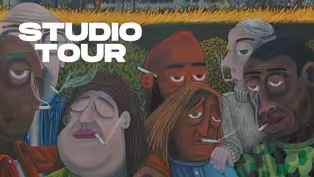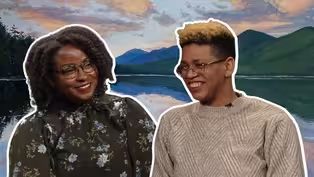
AHA! | 819
Season 8 Episode 19 | 26m 46sVideo has Closed Captions
Journey through the human experience with paintings, landscapes, and music.
Take a deep dive into the human experience with three incredible artists. Brian Cirmo’s paintings depict the emotions that lie beneath the surface. Takeyce Walter uses landscapes to inspire and uplift with her workshops and social media campaigns. Angelina Valente’s “Maybe It’s the Way” featuring JP Hubbs on the keys is a beautiful expression of the joy and pain of love.
Problems playing video? | Closed Captioning Feedback
Problems playing video? | Closed Captioning Feedback
AHA! A House for Arts is a local public television program presented by WMHT
Support provided by the New York State Council on the Arts (NYSCA), M&T Bank, the Leo Cox Beach Philanthropic Foundation, and is also provided by contributors to the WMHT Venture...

AHA! | 819
Season 8 Episode 19 | 26m 46sVideo has Closed Captions
Take a deep dive into the human experience with three incredible artists. Brian Cirmo’s paintings depict the emotions that lie beneath the surface. Takeyce Walter uses landscapes to inspire and uplift with her workshops and social media campaigns. Angelina Valente’s “Maybe It’s the Way” featuring JP Hubbs on the keys is a beautiful expression of the joy and pain of love.
Problems playing video? | Closed Captioning Feedback
How to Watch AHA! A House for Arts
AHA! A House for Arts is available to stream on pbs.org and the free PBS App, available on iPhone, Apple TV, Android TV, Android smartphones, Amazon Fire TV, Amazon Fire Tablet, Roku, Samsung Smart TV, and Vizio.
Providing Support for PBS.org
Learn Moreabout PBS online sponsorship(upbeat music) - Explore the human condition with artist Brian Cirmo, get inspired to paint with landscape artist Takeyce Walter, and catch a performance from Angelina Valente.
It's all ahead on this episode of AHA, A House for Arts.
- [Announcer] Funding for AHA has been provided by your contribution and by contributions to the WMHT Venture Fund.
Contributors include the Leo Cox Beach Philanthropic Foundation, Chet and Karen Opalka, Robert and Doris Fischer Malesardi, and the Robison Family Foundation.
- At M&T Bank, we understand that the vitality of our communities is crucial to our continued success.
That's why we take an active role in our community.
M&T Bank is pleased to support WMHT programming that highlights the arts, and we invite you to do the same.
(upbeat music) - Hi, I'm Jade Warrick, and this is AHA, A House for Arts, a place for all things creative.
Here's Matt with today's field segment.
- I'm in Albany, New York, about to step into the studio of artist Brian Cirmo.
Follow me.
(energetic music) - I'm a person who thinks that being alive and being human is a very absurd thing, and it's something I'm always trying to approach with humor, because it's (chuckles) almost too, it's almost too overwhelming to look at life and say, "Well, what is the meaning here, and what are we doing?"
(energetic music) The work that I'm making, it doesn't get made unless I'm listening to music, I'm reading, I'm watching films, thinking about personal memory, personal experience.
All that stuff is just kind of, gets synthesized into the work.
There's Cubism in there, and there's, you know, Peanuts cartoons in there.
Bob Dylan is a huge influence.
And then there's some jazz ideas in there.
So it just kinda all kinda comes through as you make the work.
(rhythmic music) There's a painting that I did a couple of years ago, and I was looking at the pool paintings of David Hockney, and another image I was obsessed with was "Vision After the Sermon", by Gauguin.
There's two figures wrestling in it, so I said, "All right, well, I wanna make a painting where two figures are fighting or wrestling, and I want it to be by a pool or something."
So that's it.
Like, I don't know where it's going from there.
As I made it, I started to think about the game we all played when we were kids, Marco Polo, that, like, that was the game I played with friends when we were in the pool, so I just all of a sudden said, "Well, what if I titled the painting 'Marco Polo'"?
And so that's kinda how ideas just kinda come together in the process of making something.
I start off with drawing.
I just sit down and I just start making lines, and a figure will arise, or a shape will come out of it.
Sometimes they're very abstract.
And then once I find something, I just, it just feels right, then I start to refine it, and revamp it, and change it.
Once I have everything figured out, composition, scale of what I want the painting to do then I transfer that small drawing onto a large painting, and then I start to make the painting, but when I go into the painting, I have a pretty solid idea of what I want.
It was all worked out in drawing.
You are made up of the things that you did when you were a child, the things you learned in art school, the things you learned about being in your studio on your own, from drawing from other artists.
All that stuff stays with you, and it all just slowly develops into something, and what you're looking for is, "How do I fit into all this?
Where can I fit into this kinda canon of art?"
I'm telling some kind of story, and it connects not only to my time, but I think it connects to the canon of art history before it.
I think any artist that's working and is serious about what they're doing is part of that.
(rhythmic music) I don't necessarily know how to build a traditional painting, layers, and glazes, and things like that.
I was taught from very contemporary painters, and so I paint wet-on-wet, and my color palettes have always been very much grays, and earth tones, and blacks, and I always just am drawn to that kind of color palette.
I did this one painting called "Gray Tree", and there's a reproduction, or I painted Mondrian's "Gray Tree" in the background.
It has this kind of, really kind of gray, ominous quality to it.
And at the time, I was reading Sinclair Lewis's "Babbit", and in the book, there's a line that says, "Gray fear loomed always by him now."
I started to think about gray matter in terms of the brain, the human brain, and this idea that it's not only a gray palette, but it's also tapping into human emotions, human experience, which is, you know, the gray matter of the brain, and I said, "I'm gonna make a series of paintings that are dealing with this very kind of ominous quality and really tap into the psychological turmoil of these characters."
(ominous music) I think anyone's job as an artist is to bear witness to their time.
I think we're all...
I don't care what kind of art you're making, what materials you're using, the subject is always the same.
It's the human condition.
How do we deal with being alive?
How do we deal with being human?
What does it mean to be human?
If we wanna melt down all the artists' statements in the history of the world, it can all be boiled down to the idea of the human condition, and for me, I have to stay engaged with that.
(contemplative music) - Takeyce Walter is a landscape painter living in Round Lake, New York.
She uses her art to uplift and inspire others through workshops and social media campaigns, like her popular Creative February Challenge.
So what sparked her love of painting?
Let's find out.
Hi, Takeyce, welcome to AHA today.
- Hi, Jade.
Thank you for having me.
- Thank you for joining us.
So I wanna talk a little bit more about who is Takeyce the artist, So I wanna talk a little bit about your art, and talk about why landscape and why is that important to you?
- Sure, so the landscape has been important to me ever since I was a child.
It's where I go to relax, to rest, to recreate.
As an adult, I often am on a lake, or hiking with my family, fishing, swimming, and the sense of connection and peace that I have while I'm in the landscape is so important to me to share with others.
- So beautiful, right?
(both laugh) Now, you don't see a lot of figures in your art, so I always wanted to ask, well, do you ever think you'll put figures, whether it's human, maybe a deer, I don't know.
(both laugh) What are your thoughts?
- Yeah, so for the past, I wanna say 10 to 15 years, my aim with landscape, as I mentioned, I go there for peace, and I've purposefully removed, so if I...
Sometimes I'll paint something and I'll purposely remove any element of humanity in the landscape because I really just want that raw land.
But more recently, especially watching my kids in the landscape, I've been curious, and now have this yearning to see people in the landscape.
I feel that as a society in general, we've kind of separated ourselves from nature, and I don't think that's, that's a good way - Not a good idea.
(Jade laughs) - to be, no, so I think it's important for me to include humans, 'cause we are a part of nature and we do need to be connected.
Some of my most wonderful core memories are of spending time in nature with my family, so I wanna explore more of that in my art.
- Ah, it's beautiful, - Thank you.
- really true, capturing memories of just not only your enjoyment in nature, probably pre being a mother, but also now capturing those same memories, but now with your children within it, - Absolutely.
- which is like, kind of like a, like, it's like double memories, you know?
- Yeah.
- It's like I have this one memory, we're in the same space, but now I'm being able to witness the beauty of my family being able to enjoy this, and I wanna capture that as well, which I think is a really beautiful thing.
- Thank you.
- So I wanna talk a little bit about black artists within landscape work.
I feel like, personally, I feel like you don't really see that many black artists in exhibitions, or exhibited through artistic organizations really highlighting black landscape artists.
Is that something that you feel as well?
And if so, why do you think that?
- Yeah, you know, when I got an interest in landscape painting, I remember taking a field trip, it was a field trip for either a college course or a high school course for art, and we went to the Met in New York, and I remember just being in front of this painting and it just stopped me in my tracks.
Like, I probably stood there for a very long time.
(Jade laughs) I was moved almost to tears by this painting, and it was a landscape painting, but it had water in it, and it was done, even though it was done in the early 19th century, it had such a contemporary feeling to it and was just really beautiful.
I can't explain just the feeling of peace that came over me from seeing that, and that's when I knew I wanted to explore landscape as a painting, as a way to express myself through painting.
So after that... And walking through the Met, there weren't many folks that were from the African diaspora represented, and I tried to do research to find other artists, particularly landscape artists, to learn from, 'cause that's, you know, as artists, that's what we, you kinda learn from role models and what you see.
A lot of the painters that I found, at least the ones who were celebrated, and in the museums, and books were written about, were many European, older, white men, and a handful of women.
And then I grew to understand that during that time, folks of the African diaspora, other minorities, were not a part of that environment.
We weren't permitted to be, you know, educated, or gain an education in art.
Folks of the African diaspora in America have sometimes, like, a conflicted relationship with the landscape.
Now, I'm Jamaican, I am an immigrant to this country, so I don't pretend to know, you know, or know what it's like to be someone of the African diaspora in this country, but I know that the access wasn't there, - It wasn't.
- and to learn landscape, with anything, you have to learn from observing, you know, so I go out in the field all the time to study my subject, to practice painting, and then bring that back to my studio.
Going outdoors, (chuckles) for folks of color, during, you know, that reconstruction era.
it wasn't necessarily the safest thing to do, so I can imagine that, historically, that could have been a factor of why you didn't see a lot of landscape painters.
Back during the Jim Crow era, you had the Highwaymen, in Florida, which were a group of several black painters who were mainly men, I think there was one woman, (both laugh) one woman, who painted the Floridian landscape, that they were beautiful.
But, yeah, I've been able to only find a handful of female black artists - That's crazy.
who are notable enough to be written in history.
I'm sure there were, you know, artists who were trying to do their thing, or amateur artists who were painting landscapes, but in terms of who's celebrated and written about, it's- - There's not many.
- There aren't many, no.
- So what is something that if you could say to the folks watching who have the power to give these types of artists, you know, artists of color who work within nature-derived and landscape art, what would you tell those people?
How could they make sure that black artists have access to this type of craft?
- I would say, you know, for those who are privileged and in the realm that they have the power to give folks access is to provide that access.
Show them, show upcoming art students, kids, show them that there are landscape painters out there of all different, you know, ethnicities, and backgrounds, and experiences.
For me, to be a landscape painter today, you know, in 2023 America, it's a privilege for me.
I'm able to share that with others.
I started a youth program with a couple of nonprofits in the area to give youth access to art and the environment.
That's actually the name of the program (chuckles), Art and the Environment.
- Wow.
- And I worked with the Nature Conservancy, I'm a member of their board in the Adirondack chapter, and also with Black Dimensions in Art, which is a local art nonprofit.
We had 10 youths from the Albany area, and we went to various preserves that are stewarded by the Nature Conservancy, and we brought our watercolors.
So we hiked, we went to a waterfall, we went to the Albany Pine Bush, and the kids were just so engaged, they were so connected and centered with what was going on.
They were looking at the various plant life, and trying to identify them with the, you know, the Nature Conservancy had a couple of their stewards with us, and it was such a fulfilling and rewarding experience.
- So I wanna ask you one more thing, is Creative February.
So you have these beautiful youth programs, and I know you have some for adults as well, but I know you also do something with Creative February which also helps uplift artists, so would you give us a little bit of information about that?
- Oh, yeah, absolutely.
And today's, happy Creative February, it's February 1st.
- Yeah, first day.
- Yes.
So Creative February is, it's now become a community art project that started, really, as a personal art project about nine years ago.
I, as a working mom and artist, you know, I was struggling to find time to commit and dedicate to my art, and that year, for my birthday, I told my husband, "I just need some time in my studio with me and my art supplies.
That's it."
- That's all we all want.
- That's all, yeah (laughs) that's the dream.
And he said, "Okay," (laughs) you know, and I was like, "Oh, all right, so this is what we're doing."
And I have a good friend who shares my birthday.
She's also an excellent artist, her name is Kate Edwards, and I called Kate up and I said, "Kate, this is what we're doing (chuckles) for our birthday this year."
That first year, we did accomplish the goal of working on something every single day.
We had a show that year, it was called Every Day, at the Spring Street Gallery in Saratoga Springs.
- Love it.
- And subsequent years, you know, we've kept going, and as the movement grew, we started inviting other artists to participate.
Now we have a dedicated social media presence.
We have a Facebook group, we also also have a branded hashtag, #CreativeFebruary, that we use online to connect with others.
- It's only getting bigger.
- Yeah.
- So folks, follow Creative February or Facebook, (both laugh) also hashtag it.
(Takeyce laughs) Well, thank you, Takeyce, it was great talking to you about all your passions and how much you do provide to the creative community, and I enjoyed speaking to you today.
- Thanks so much for having me, Jade.
- Of course.
Please welcome Angelina Valente.
(instrumental music) ♪ Brother, I've been feeling heavy ♪ ♪ And I know you have, too ♪ ♪ So come sit right down beside me ♪ ♪ And our troubles will be few ♪ ♪ I'm gonna lay down by the riverside ♪ ♪ And listen to the water as it rolls ♪ ♪ It's the sweetest kind of music ♪ ♪ Just listening to those wild flowers grow ♪ ♪ What good can it do ♪ ♪ Letting that weight bear down on you ♪ ♪ I'm gonna lay down by the riverside ♪ ♪ And listen to the water roll ♪ ♪ Water roll ♪ ♪ Gonna bathe in water gently ♪ ♪ Water ♪ ♪ Gonna drop those sins ♪ ♪ Sins ♪ ♪ From years ago ♪ ♪ Gonna let my soul ♪ ♪ Soul ♪ ♪ Begin again ♪ ♪ Forget those stories ♪ ♪ Stories ♪ ♪ I've been told ♪ ♪ I'm gonna lay down by the riverside ♪ ♪ And listen to the water as it rolls ♪ ♪ Mm-mm ♪ ♪ It's the sweetest kind of music ♪ ♪ Just listening to those wild flowers grow ♪ ♪ What good can it do ♪ ♪ Letting that weight bear down on you ♪ ♪ I'm gonna lay down by the riverside ♪ ♪ And listen to the water roll ♪ ♪ To the water roll ♪ ♪ Come a little light shining through ♪ ♪ All those dark ♪ ♪ Dark ♪ ♪ And lonely nights ♪ ♪ 'Cause I know ♪ ♪ Know ♪ ♪ There is truth ♪ ♪ And so I'm giving up ♪ ♪ Giving ♪ ♪ The fight ♪ ♪ I'm gonna lay by the riverside ♪ ♪ And listen to the water ♪ ♪ As it rolls, rolls ♪ ♪ It's the sweetest kind of music ♪ ♪ Just listening to those wild flowers grow ♪ ♪ What good can it do ♪ ♪ Letting that weight bear down on you ♪ ♪ I'm gonna lay down by the riverside ♪ ♪ And listen to the water roll ♪ ♪ Listen to the water roll ♪ ♪ I'm gonna listen to the water roll ♪ ♪ I'm gonna listen to the water roll ♪ (guitar music) ♪ Something about this place ♪ ♪ Just makes me feel at home ♪ ♪ Full of people who are at the piano all alone ♪ ♪ But I feel just fine, ♪ ♪ Just fine ♪ ♪ Something about this place ♪ ♪ Just makes me want to cry ♪ ♪ Like seeing an old friend ♪ ♪ You've been missing for a while ♪ ♪ But I feel just fine ♪ ♪ Just fine ♪ ♪ Our sun rises in the east ♪ ♪ And it sets down in the west ♪ ♪ But there's something about our stars ♪ ♪ They shine brighter than the rest ♪ ♪ Maybe it's the way ♪ ♪ People never change ♪ ♪ How I've known my best friend ♪ ♪ Since before the first grade ♪ ♪ Or maybe it's how ♪ ♪ I had to come back down ♪ ♪ To fit all the pieces ♪ ♪ That were missing until now ♪ ♪ I look across the street ♪ ♪ And think about high school ♪ ♪ Stuck on that stupid boy ♪ ♪ Or with my nose in some book ♪ ♪ But I feel just fine ♪ ♪ Just, just fine ♪ ♪ Our sun rises in the east ♪ ♪ And it sets down in the west ♪ ♪ But there's something about our stars ♪ ♪ They shine brighter than the rest ♪ ♪ Maybe it's the way ♪ ♪ People never change ♪ ♪ Or how I've known my best friend ♪ ♪ Since before the first grade ♪ ♪ Or maybe it's how ♪ ♪ I had to come back down ♪ ♪ To fit all the pieces ♪ ♪ That were missing until now ♪ ♪ I stop and take a look ♪ ♪ At this old town ♪ ♪ One of those places ♪ ♪ You're always itching to get out ♪ ♪ But I know I wouldn't be ♪ ♪ All that I am ♪ ♪ Without its scenery ♪ (instrumental music) (chiming music) - Thanks for joining us.
For more arts, visit wmht.org/aha and be sure to connect with us on social.
I'm Jade Warrick, and thanks for watching.
(upbeat music) (upbeat music continues) (upbeat music continues) (upbeat music continues) - [Announcer] Funding for AHA has been provided by your contribution and by contributions to the WMHT Venture Fund.
Contributors include the Leo Cox Beach Philanthropic Foundation, Chet and Karen Opalka, Robert and Doris Fischer Malesardi, and the Robison Family Foundation - At M&T Bank, we understand that the vitality of our communities is crucial to our continued success.
That's why we take an active role in our community.
M&T Bank is pleased to support WMHT programming that highlights the arts, and we invite you to do the same.
Video has Closed Captions
Preview: S8 Ep19 | 30s | Journey through the human experience with paintings, landscapes, and music. (30s)
Angelina Valente Performs "Maybe It's the Way"
Video has Closed Captions
Clip: S8 Ep19 | 4m 13s | Singer Angelina Valente and JP Hubbs bring the groove with "Maybe It's the Way." (4m 13s)
Angelina Valente Performs "Riverside"
Video has Closed Captions
Clip: S8 Ep19 | 3m | Catch Angelina Valente's soulful performance of "Riverside" featuring JP Hubbs on keys. (3m)
Exploring the Human Condition Through Brian Cirmo's Painting
Video has Closed Captions
Clip: S8 Ep19 | 5m 39s | Brian Cirmo's paintings offer a unique perspective on the human condition. (5m 39s)
Finding Inspiration in Nature: The Art of Takeyce Walter
Video has Closed Captions
Clip: S8 Ep19 | 10m 39s | Discover how landscape painter Takeyce Walter empowers others through art. (10m 39s)
Providing Support for PBS.org
Learn Moreabout PBS online sponsorship

- Arts and Music

Innovative musicians from every genre perform live in the longest-running music series.












Support for PBS provided by:
AHA! A House for Arts is a local public television program presented by WMHT
Support provided by the New York State Council on the Arts (NYSCA), M&T Bank, the Leo Cox Beach Philanthropic Foundation, and is also provided by contributors to the WMHT Venture...
